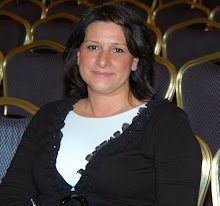
“Who ever offered the wine of movement;
The beautiful intoxication of motion
And who ever has been taught to walk
That person will always know
How incredible it maybe
That everything is possible anywhere
People can overcome any monster
If they have the will, heart and the intelligence
The magic consciousness always helps.” Zoltan Vito
I put up a posting on 4th February titled ‘Is Conductive Education turning into an umbrella term like CP?' for discussion.
I believe that it is worthwhile to post the comments. If you would like to join the discussion please do so in any language you feel most comfortable to express yourself with.
Ági in her last comment gave a link to
Minöségirányitási /Inspectoral CE Program of The Petö Institute on the peto.hu(gyki-mip2008) website. I couldn’t access that link. With Ági’s help I found it.
The Inspectoral CE Program of The Petö Institute's PDF file is 241 pages and it is solely written and published by The Petö Institute in Budapest, Hungary.
http://www.peto.huPlease follow this link:
http://www.peto.hu/dokumentumok/index.php?option=com_docman&Itemid=55When you get there you will have to scroll down the page and click on Intézményi Minőségirányítási Program 2008. II. kötet.
The above link was provided by Andrew Sutton
http://www.conductive-world.infoThank you Andrew!
If you have problems accessing it please find direct link to it at:
http://www.szathmarytc.com/media/gyki-mip2008-2.pdfOriginal posting:
I am as grateful as ever for questions like this coming from my fellow Conductors because it helps me to write about some of the burning issues we all have to face with when we are running Conductive Education Programmes.
Background:
When I started my work in England and abroad I was quite surprised when I read reports about children or when I enquired to the children’s diagnosis during initial consultations, because most of the time I was told that the children have ‘Cerebral Palsy’.
I was quite taken back, as Cerebral Palsy didn’t give me enough background information about the unique characteristics of the actual manifestation of the type of Cerebral Palsy.
Each type of Cerebral Palsy has unique psychological, emotional, cognitive and physical characteristics, which have to be taken into consideration when we are looking at a person whose life is affected by them.
Even though Conductors look ‘beyond the underlying conditions’ we do need to take serious note of the diagnosis and look at how each person is affected in their daily life.
Identifying and recognising the problems are one of the most important steps in our work. Although we do not focus on them as we are trained to focus on other aspects, which we CAN build upon using step-by-step solutions in a unique, sophisticated and dynamic way.
So there this is the background to the question.
Well… is Conductive Education turning into an umbrella term like Cerebral Palsy?
I would like to open this question up for discussion. What is your opinion?
There seems to be so many variations of Conductive Education now, even from when I was trained at he Petö Institute (between 1980-1984). Conductors often tell me that they prefer working on a mat instead of on a plinth and that is what they learnt at Petö. Facilitation techniques, the rhythm and execution of movements are less and less defined, leading performance, programme structuring varies greatly.
I sometimes see photographs of children from around the world and from the Petö Institute in various situations, which in my day would not have been allowed.
This question is not meant to be critical in any way, but has exposed a serious issue, which I feel is worth discussing.
If you feel you would like to comment, please feel free and I welcome comments from all angles.
To save confusion, perhaps I should say to write your comments within a week of today please.
Posted by Judit Szathmáry at 15:51
5 comments:
Andrew Sutton said...
I should like to take a small exception with something that you write here.
I fully concur that the term 'cerbral palsy' is frequently bandied around in this country, the UK, in an exceedingly sloppy way, blurring all sorts of potentially important disinctions. I wholly agree with you therefore when you write:
'Even though Conductors look ‘beyond the underlying conditions’ we do need to take serious note of the diagnosis and look at how each person is affected in their daily life.'
But I wonder whether your proceeding paragraph to qualify this offers qualification enough as it stands:
'Each type of Cerebral Palsy has unique psychological, emotional, cognitive and physical characteristics, which have to be taken into consideration when we are looking at a person whose life is affected by them.'
I can't go with this, certainly not as it is stated. Forgive me if I probe more deeply into what you wrote.
Surly all human development, all human personality is a dynamic product of systemic transactions between the bodily, the social and the psychological. By this analysis, no personal characteristic can be regarded as the product of a particular brain damage, however localised. This is surely a mechanistic analysis, since it leaves out the contibution of social and psychological factors in bringing about that characteristic.
I don't know whether this bears on your analogy between the concepts of cerebral palsy and Conductive Education, which I think offers a nice peg for wider discussion. Thanks for pushing the boat out.
Andrew.
04 February 2009 17:36
Judit Szathmáry said...
Dear Andrew,
Thank you for your comment. It is lovely to have you here on my little cyber patch. Please do visit more often.
If there is a physical manifestation, which characterises of each type of Cerebral Palsy, surely there has to be a psychological, emotional and cognitive manifestation. They are not as visible as the physical, but they are all interconnected and interrelated with each other.
The physical cannot be separated and cannot just stand on its own as the only characteristic of a certain type of Cerebral Palsy.
I believe and I was taught that each classification of Cerebral Palsy and each type neurological condition have certain psychological, cognitive and physical traits.
I wasn’t talking about human beings with their unique built and individual characteristics and their own dynamic multilevel response to social, cultural and environmental demands, which will create their own personal characteristics.
You were right to point it out as from my writing it wasn’t clear.
Thank you.Judit
04 February 2009 19:55
Agi said...
The only criterion of registering as a Conductive Education Center is to employ a conductor, according to the NICE website. I have heard from parents that there are CE places in the UK and the USA with plinths and ladderback chairs without a conductor, although they might not have been able to register themselves.
Background:
In my carrier so far, I have worked as a conductor (in its pure sense) also as a special educational teacher using conductive input (task series, complex physically and cognitively active programmes). I have also worked as a special education teacher with a conductive/humanistic approach but with hardly any input
(suction bars, rings and physically and cognitively accessible and achievable Curriculum/lesson plans.).
There were times when I knew what the job was going to involve, and there was a time when this came to me as a surprise, and I just had to deal with it. I have conductor friends who work as primary teachers (surely with a conductive approach), therapists (Feldenkrais, Ayres, Deveny SMT), special education teachers with more or less conductive input, or special advisers working with individuals with complex and profound difficulties and/or behaviour problems.
Due to the changing world and the job vacancies, conductors are willing or they need to work differently with children with all kinds of motor and learning difficulties to support themselves as individuals. It is up to every individual what they do and how they use their skills. We are all here to grow. But it doesn’t change their qualification, so I think that the criterion above is not relevant.
The underlying question in here is what makes Conductive Education pure and authentic.
I think to answer this, the best way is to listen to people who worked with Professor Peto, and examine the Peto legacy: films, lectures, university notes, generations that still carries the memory of the Peto-time, see the film archives which stand as a proof of evidence for originality.
Conductive Education is an educational method that teaches individuals with motor disorder to overcome problems of movements and conducts/ enables them to live a more active and/or independent life. This is a well-known definition and it clearly implicates that CE participants are cognitively willing and able and their primary disability is the motor disorder.
Zoltan Vito a well-respected Hungarian poet-writer, studied in the Peto Institute during the 60s.
His words are explanatory and inspirational for the present and for the future conductive students, their parents and conductors.
“Who ever offered the wine of movement;
The beautiful intoxication of motion
And who ever has been taught to walk
That person will always know
How incredible it maybe
That everything is possible anywhere
People can overcome any monster
If they have the will, heart and the intelligence
The magic consciousness always helps.”
07 February 2009 03:37
Judit Szathmáry said...
Dear Ági,
Thank you for your comment. I always examine issues or problems from many angles and through a lens, which I can move close to the issue and I also can widen to look at the issue form a distance. It helps me to find a range of solutions and choose the one, which fits into my values.
I believe it all comes down to individual values; certain values
of course change as we grow and develop on our path of learning.
From my point of view I have values, which I was born with and they are strong and unshakable and I have values, which I learnt through my experiences and my studies.
When conductors work on their own they have only their own value systems to guide them. It can be a very lonely path as at the Petö Institute conductors always work as part of a kind of beehive system.
Everything is well designed and there are always many different levels of expertise available on the spot.
There is an established value system, and a ‘professional culture’ that provide a safety net, comfort and security. It is a kind of tribal conciseness with its own hierarchical structure.
When people are removed from this and try to represent the system on their own they face many internal and external difficulties.
Even if we just freeze the picture here and look at how many fresh graduates are out in the world doing their best but required to run classes on their own or establish programmes and projects.
When conductors required to transfer their professional skills based on specific values in to already existing systems i.e. multidisciplinary systems, special education systems, primary and secondary education systems I assume they do it with an understanding that this is a skill itself and cannot be learned from books only from experience.
It is vital before accepting a job to have an agreed and signed job description. It saves both employer and employee from any possible
misunderstandings.
I loved the poem, thank you for sharing it.
I am grateful for all and any further comments, as I believe it is just the beginning of the conversation.
Since I put up this post our staff had some really interesting conversations about it. If nothing else it really made us think.
Szeretettel, Judit
08 February 2009 09:22
Agi said...
Kedves Judit,
Thank you for your answer. I agree with every word you said.
Regarding the point I was trying to make about the fact that the job responsibilities of a conductor
is widely expanding, is that it can be one of the reason why Conductive Education might be turning into an umbrella term.
It is hard and is emotionally and professionally challenging to meet the new ‘conductor’ requirements; especially abroad. However these problems show up in Hungary as well.
I’ve found this fascinating document, called Minosegiranyitasi /Inspectoral CE Program of The Peto Institute on the peto.hu(gyki-mip2008) website. It talks about the work of a professional team who defines the standards and examines the quality of the conductive practice within the Institute. As part of their future improvement plan, this professional pedagogical body aims to establish the criteria of Conductive Education by 2012. This is exiting and it surely will have an effect on the conductive practices abroad alike.
Szeretettel,
Agi
 I had a very strange day today. I was meant to go to London for consultancy work, but we agreed to hold up that meeting. I received an e-mail this morning from a friend that Gill the librarian an old friend and a fellow colleague was made redundant at the National Institute of Conductive Education! Frankly I was shocked.
I had a very strange day today. I was meant to go to London for consultancy work, but we agreed to hold up that meeting. I received an e-mail this morning from a friend that Gill the librarian an old friend and a fellow colleague was made redundant at the National Institute of Conductive Education! Frankly I was shocked.
























